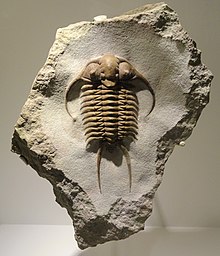| Cheiruridae Temporal range:
| |
|---|---|

| |
| Paraceraurus exsul, Middle Ordovician, St. Petersburg region, Russia | |
| Scientific classification | |
| Domain: | Eukaryota |
| Kingdom: | Animalia |
| Phylum: | Arthropoda |
| Class: | †Trilobita |
| Order: | †Phacopida |
| Suborder: | †Cheirurina |
| Family: | †Cheiruridae Hawle & Corda, 1847 |
| Subfamilies | |
| |
Cheiruridae is a family of phacopid trilobites of the suborder Cheirurina.[1] Its members, as with other members of the suborder, had distinctive pygidial modified into finger-like spines. They first appeared in the uppermost Cambrian (upper Furongian), and persisted until the end of the Middle Devonian (Givetian). Currently about 657 species assigned to 99 genera are included.[2]
- ^ F. Perez-Peris, L. Laibl, M. Vidal, A. Daley (November 2021). "Systematics, morphology, and appendages of Anacheirurus (Pilekiinae, Trilobita) from the Fezouata Shale and the early diversification of Cheiruridae". Acta Palaeontologica Polonica. 66. doi:10.4202/app.00902.2021. S2CID 244734312.
{{cite journal}}: CS1 maint: multiple names: authors list (link) - ^ J.M. Adrian (2014). "20. A synopsis of Ordovician trilobite distribution and diversity". In D.A.T. Harper; T. Servais (eds.). Early Palaeozoic Biogeography and Palaeogeography. Memoirs of the Geological Society of London. Vol. 38. Geological Society of London. p. 490. ISBN 978-1862393738.